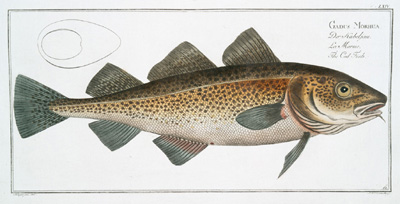

• Intro / Home
• Historical Neighbors
• Street and Backyard
Neighbors
• Park and Green Places
Neighbors
• Shore and Wetlands
Neighbors
• Salt and Freshwater
Neighbors
• Tiny Neighbors
• Unwelcome Neighbors
• Occasional and
Unexpected Neighbors
•
Wildlife Sighting Log
• Resources
• Hours and Tours
• Press Release
• NYPL HOME
| Salt and Freshwater Neighbors | |
 |
||
|
|
Atlantic Cod are historically one of the most important commercial fishes, and have been called "the beef of the sea." They are omnivorous predators of invertebrates and smaller fishes, and are widely distributed on both sides of the north Atlantic Ocean, including New York’s marine and brackish waters. Cod are long-lived, and can grow to over 4 feet long, although the average size of a three-year-old fish is approximately 2 feet. Fish sold as Scrod are actually smaller young Cod. Marcus Elieser Bloch (1723–1799), a German physician, based his landmark ichthyology on his own collection of some 1,500 local and foreign fishes. Most of this historic collection still exists in the natural history museum of Humboldt University in Berlin.
|